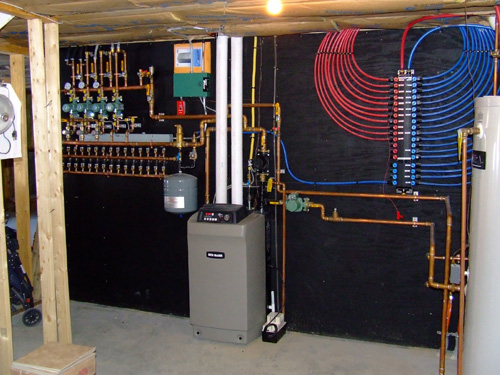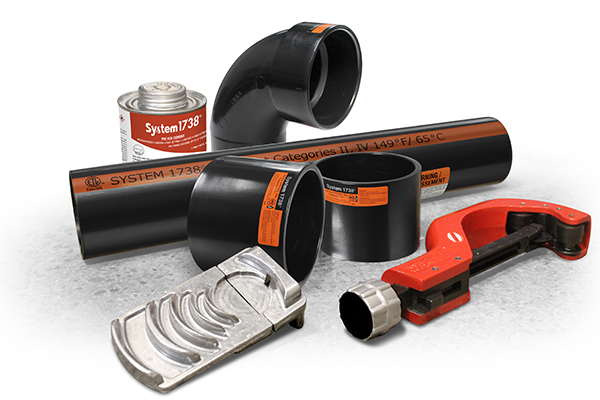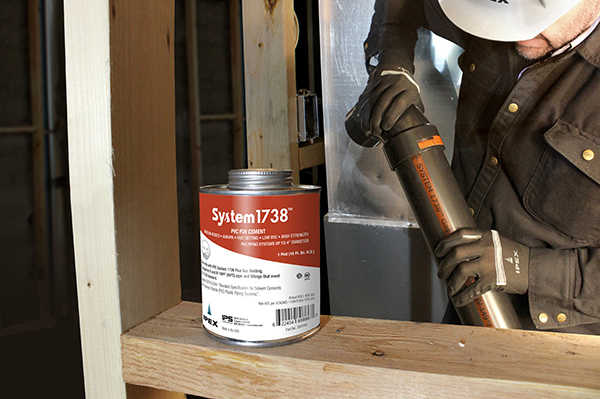PVC Flue Gas Venting Pipe
System 1738 – Engineered PVC Flue Gas Pipe
Years ago we started installing gas boilers that allowed venting through PVC Drain Waste Venting (DWV) piping. The use of PVC DWV piping to vent the boilers made for easy routing of vent pipes and the ability to vent up through the roof much like plumbing vent stacks. Until recently the industry didn’t have standards that addressed the practice of venting flue gasses with PVC DWV piping. So for many years gas boilers were installed with traditional PVC DWV piping like the picture shown below (boiler in my own home!).
Unfortunately, traditional PVC DWV piping was never designed or certified for transmitting gasses, rather it was only designed and certified to carry liquids. Obviously, the release of CO gasses into the home could be a very serious safety issue resulting in CO poisoning and possibly death. As a result, new standards have been developed to specifically address the use of non-metallic piping to vent gas appliances. That new standard is UL 1738 – UL Standard for Safety Venting Systems for Gas-Burning Appliances.
Recent changes in both the NFPA 54-18 and IFGC-18 Fuel Gas Codes now recognize the UL 1738 venting standard. The UL 1738 venting standard ensures that the entire system including the piping, fittings, accessories, and solvents, is designed to carry flue gasses safely. UL 1738 also requires that products to be labeled for easy identification. In order to ensure the integrity of the venting system, the UL 1738 Standard stipulates the following: Do NOT mix pipe, fittings, solvents, or joining methods from different manufacturers.
There are several products available on the market that meet the UL 1738 standard. One of those products is System 1738 Flue Gas Venting from IPEX.
System 1738
System 1738 is the first engineered PVC Flue Gas Venting System certified to UL 1738; it is certified for Category II and IV gas burning appliances. The system is rated for flue gas temperatures up to and including 149°F (65°C). Pipe sizing includes 2″, 3″ and 4″ along with corresponding fittings, cement, and venting accessories. Some of the benefits of using System 1738 include:
- Fully certified as a complete system of pipe, fittings, cement and venting accessories.
- Permanent solvent welding joining system.
- Material type, temperature rating and product certification are included in the pipe print line and fitting certification sticker.
- Carbon monoxide warning label.
- Solvent cement formulated for the application.
- Availability of cutting and beveling tools to ensure proper joint installation.
- Terminations and accessories can be painted to match building exteriors.
- Installation training and literature support.
- National Distribution
What Does This Mean for Homeowners?
So the real question is: What does this mean for homeowners? If you’re having a new gas fired appliance installed in a new or existing home be sure to ask your heating professional if the venting system meets the new UL 1738 standard. Any pipe that meets the standard will have “flue gas vent” printed on the pipe. If you have an existing gas fired appliance that uses traditional PVC DWV piping it’s important to ask your heating professional to inspect your current vent piping and discuss options for meeting the UL 1738 standard. If you are about to install a new gas fired appliance or decide to have your flue gas vent system changed, hire a professional to do the work. Because of the risks, this is not a DIY job.

















Can a 50 gal GE hot water heater be converted with a power vent, or should the hot water heater have this feature already as a unit?